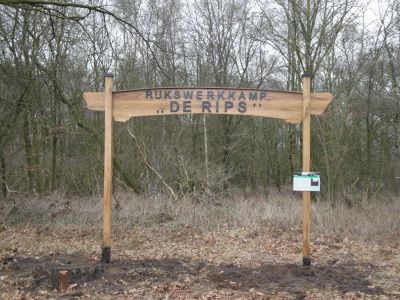Rijkswerkkamp de Rips (infopaneel versie)
Contents
1 State work camp De Rips (info panel version)
1.1 Buildings
2 Provision of work
2.1 Chinese
3 English command post and field hospital
3.1 Canadian radar unit
3.2 Training camp for war volunteers and soldiers
3.3 Timber yard
This is a short version about the history. The entire history can be found under the version: WWII: Rijkswerkkamp, De Rips (disappeared)
At this site was the De Rips government work camp. The camp served in various forms from late 1940 to early 1948.
Replica of the entrance gate with info panel of the former Reichwerkkamp De Rips. Buildings
The Reichwerkkamp consisted of four wooden living-sleeping barracks with a dozen open latrines (toilets) next to them. At the front was a dwelling with kitchen, associated storeroom and a large canteen. A total of 192 people could be housed there.
The buildings …
Contents
1 State work camp De Rips (info panel version)
1.1 Buildings
2 Provision of work
2.1 Chinese
3 English command post and field hospital
3.1 Canadian radar unit
3.2 Training camp for war volunteers and soldiers
3.3 Timber yard
This is a short version about the history. The entire history can be found under the version: WWII: Rijkswerkkamp, De Rips (disappeared)
At this site was the De Rips government work camp. The camp served in various forms from late 1940 to early 1948.
Replica of the entrance gate with info panel of the former Reichwerkkamp De Rips. Buildings
The Reichwerkkamp consisted of four wooden living-sleeping barracks with a dozen open latrines (toilets) next to them. At the front was a dwelling with kitchen, associated storeroom and a large canteen. A total of 192 people could be housed there.
The buildings consisted of black-painted wooden boards, a fairly flat saddleback roof and had white door and window frames.
The entire camp was cordoned off with a pointed wire fence. The main entrance consisted of a large wooden arch construction with the inscription: Rijkswerkkamp De Rips.
Initially, the work camp was intended to accommodate unemployed people put to work from the National Service for Work Expansion. Not to be confused with the post-war D.U.W. They worked in the Rip forestry and helped in the reclamation of heathland.
Chinese
In 1941, about 120 Chinese boatmen were housed in the labour camp. They could no longer set sail because of the Rotterdam port, blocked by the war. They were put to work in the Ripse woods and clearings in the Peel and left again for Rotterdam on 5 August 1944 when the British were approaching here.
At the end of World War II, the camp was used as a command post and field hospital by the British Army and Air Force.
Aerial view of De Rips government work camp Canadian radar unit
As the last Allied unit, the camp was used to house a Canadian radar unit. From the grounds of the former Bazi camp, they sent British and American bombers to their targets deep in Germany. Built by the Germans in World War II, the Bazi camp was located near the current junction of Landmeter van Beurdenweg and Hazehutsedijk roads in the corner of the Stippelberg forest.
Training camp for war volunteers and soldiers
After the war, it was a training camp for O.V.W. (war volunteers). They received basic training here before being sent to the Dutch East Indies. Lastly, conscripts who would serve in the East Indies were also trained here.
Timber yard
From 1942, the Heidemij timber yard was located here behind the camp, where logs were cut for wood gas generators at the time due to the lack of petrol. After the disappearance of the camp in the early 1950s, large quantities of wood were then brought in, which were peeled, shortened and pointed. These were then traded. The yard was closed on 23 May 1980. Subsequently, forest was planted again.

